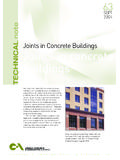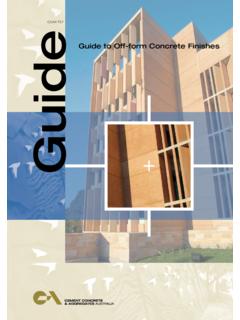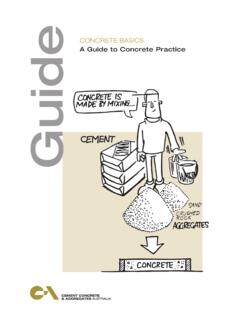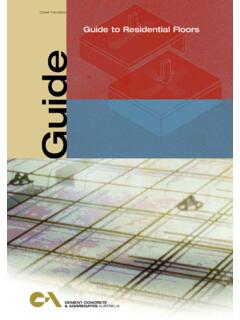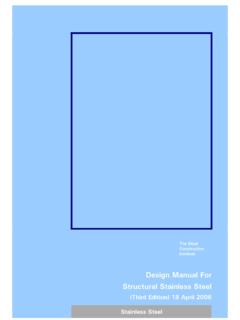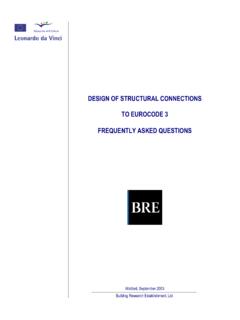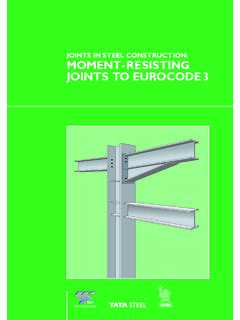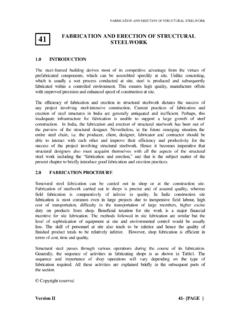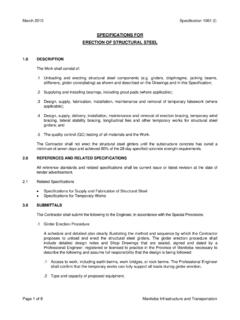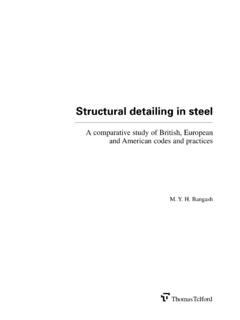Transcription of Concrete Panel Buildings
1 Panel systems and dimensions Stability and temporary bracing Roof bracing and lateral support Connection to structural steelwork Shear walls and moments on panels Support of panels Ground floor slab plan details Connecting suspended slabs to panels Shop detailing of panelsConcrete Panel BuildingsDesign Considerations for Low-rise Industrial and Commercial BuildingsIntroductionConcrete Panel construction is increasingly beingused for the entire range of Buildings , fromresidential to high-rise. This Briefing Noteoutlines some of the engineering design issuesthat should be considered in the use of this typeof construction for industrial or commercialapplications, irrespective of whether the concretepanels are cast on-site or factory Cement and Concrete Association ofAustralia acknowledges the significantcontribution of Ian Hymas from H & HConsulting Engineers Pty Ltd (trading as Henry& Hymas) to the content of this ConsiderationsThe structural design process is commenced bydividing the walls into panels of appropriatesize.
2 This involves:Site constraintsThe constraints of the site may determine themaximum size and weight of Panel that can belifted into position, and whether or not panelscan be cast on-site. For example a narrowallotment, basement or slope may not allowcrane access or space to cast panels, whileoverhead power lines may limit the height of the crane the increasing use of Concrete Panel construction for the entire range ofbuildings from residential to high-rise, and whether the Concrete panels are cast on-site or factory precast, this Briefing Note outlines some of the engineering design issues that should be considered in the use of this type of 2- Briefing 08 JANUARY2003 Joint locations Door and window openings should beconsidered when determining thelocation of joints. The Panel widthnext to an opening, and the paneldepth over a wide opening, mustprovide sufficient structural strengthto allow for the support of the Panel ,plus lifting and erection forces.
3 Economics structural layout - the structural layout, particularly the rafter spacing, will often determine the joint locations and Panel dimensions. Panel dimensions should not dictate the frame spacing as the cost per square metre for panels of comparable size is about the same, whereas closer than optimum frame spacing can incur considerable extra cost. If factory precast panels are used, transport restrictions on Panel size may dictate the layout. Construction at or near the boundary - if walls are located at or near the boundary, this will affect the footing design. Also, if adjacent Buildings are on the boundary, consideration needs to be given to matters such as the erection process, base joint details, sealing of wall joints and flashing between Buildings , as work must be completed from one side only.
4 Rafters supported by panels - can the Panel layout and openings allow panels to be designed to carry the roof framing, or are columns required in some locations? Casting areas - can the floor slab be used as a casting bed or are temporary casting beds required? To ensure the quality of panels, the surface tolerances, joint details (sealing of joints) and surfacefinishingrequirements should be considered. Panels precast off-site will eliminate the need for areas to be made available for casting, a significant consideration if thesite is congested. Stack casting - the stacking order to enable an efficient erection sequence should be considered. Panels with openings should preferably be placed on topof stacks to eliminate the need for blocking out the openings to form subsequent panels. Cranage - consideration should be given to matters such as crane capacity, lifting locations to minimise the number of setups and :While the Engineer needs toconsider all these matters, othersinvolved in the process also haveresponsibility for specific areas, egcasting, delivery sequence, cranage,temporary of the buildingThis involves both the utility andaesthetics of the building.
5 Utilitycovers items such as therequirements for access, column-free space and flexibilityto meet the needs involves anacceptable level of finishto the panels and facadefeatures to give anappealing for laterremoval of panels to createopenings or allow the building tobe extended may also be SizeWhile the final practicality of liftingpanels must be verified with thecrane contractor using appropriatecrane charts (for the available crane),the information in Table 1can beused as a starting guide to the panelweights that can be lifted by varioussized cranes. Heavy panels are panels thecrane may lift from a favourableposition, ie lifted and erected closeto the crane setup position. It isunlikely that all panels will be heavy panels, so a few heavy panels may be able to beaccommodated by planning thecasting location or delivery access,and crane setup with respect to thefinal Panel the crane size has beenconfirmed, the Panel area and sizecan then be determined.
6 As a guide,for the common Panel thicknesses,the Panel weights for a concretedensity of 2400 kg/m3are given inTable 2. For heavily reinforcedpanels, the additional weight of thereinforcement may need to beconsidered to accurately determinethe appropriate SystemsConcrete panels can be used eitheras cladding to the building, or aspart of the loadbearing structure,supporting roof and wind loads,Figure panels as loadbearingelements generally reduces theoverall cost due to a decrease in theweight of structural steelworkrequired. Even though more roofbracing is required, eliminating thecolumns usually provides greatersavings. Also, in terms ofthe programming, thepanels can be cast anderected prior to thedelivery of steelwork ,allowing time forfabrication of thesteelwork. If the concretepanels are used ascladding, the steelworkis usually on the criticalpath for the 1:Crane size to Panel weightCrane CapacityTypicalHeavy(t)(t)(t)50 (hydraulic)10 - 15187012 - 1823120 - 14018 - 253520010 - 2850 Panel WeightTable 2:Weight of common Panel thicknessesPanel thicknessPanel weight(mm)(t/m2) DimensionsHaving assessed the maximum panelweight that can be lifted, the paneldimensions can be determined byconsidering the wall height andlengths required, and any openings to be site-cast panels withopenings, while the following rules of thumb provide a starting point indetermining the minimumdimensions for legs, mullions andspandrels, the requirements for eachindividual Panel need to beconsidered.
7 Referring to Figure 2: 600 mm is usually a comfortable minimum leg or mullion width. 900 mm is usually a comfortable minimum spandrel leg and mullion widths mayneed to be more than 600 mm inwidth, Figure leg and mullion widthscould be less than 600 mm in width, Figure 4. If in doubt, a useful test isto consider if the Panel would still bestructurally satisfactory without themullion. If the answer is yes, then itmay be possible to reduce themullion width to less than 600 , consideration should begiven to the vulnerability of thinmullions to damage by accidentalloading during factory precast panels,minimum leg, mullion and spandreldimensions may be controlled bytransportation requirements ratherthan lifting stresses 08 JANUARY2003 - Page 3(a): Cladding(b): LoadbearingCladding Panel attachedto portal framePad footingLoadbearing panelcarrying raftersPad footingStarterbarsEdge-strip cast laterSpandrelPanel legsSpandrelMullions60090090060060060060 0 These dimensionsmay need to bemore than 600 mmThis mullionelement could beless than 600 mmThis leg elementcould be lessthan 600 mmNote: Leg elementscould be vulnerableto damage during erectionNote.
8 If mullion or leg elements were removed,panels would still be structurally adequate and,therefore, these widths are not criticalThis leg elementcould be less than 600 mmFigure 1:Types of Panel systemsFigure 2:Minimum recommended widths/depths of Panel legs, mullions and spandrelsFigure 3:Situations where leg or mullion widths may need to be more than 600 mmFigure 4:Situations where leg or mullion widths could be less than 600 mmPage 4- Briefing 08 JANUARY2003 Building StabilityConcrete Panel Buildings may beprone to progressive collapse, andredundancy should be incorporatedinto the structural system thatprovides stability and robustness. Forinstance, the failure of a singlebracing member due to an eventsuch as a fire, accident or abuse,should not lead to the collapse of thebuilding. Consideration maytherefore be given to providing twosets of cross bracing to give analternative load path, Figure should be exercised inusing purlins as part of the roofbracing system because of thedeflections and secondary moments(particularly if bracing members arelocated in different planes) that mayoccur.
9 Also, they are prone to earlyfailure in a Bracing (Props)Temporary bracing is used to supportthe panels prior to theirincorporation into the final is the stage where stability ofthe erected panels, and prevention ofcollapse are critical. Considerationshould be given to the following: Each Panel should typically be supported by a minimum of two braces. Braces should be positioned so that they are uniformly loaded, ie if using three braces, they should be spaced along the Panel so that the central brace carries one third of the loading. Panels should not be braced off other temporarily braced panels unless specified by the Panel Engineer (refer section on shop detailing of panels). This also applies to leaning panels against other panels, during say relocation of the crane or while lifting panels further down the stack, which must be erected first.
10 If temporary braces are skewed (ie not perpendicular to the panels in plan), then the design and installation of the Panel , as well as the support of the brace, need to be checked for the loads induced by the skewed brace. Only superimposed loads that have been designed for are to be applied to panels while temporarily braced, as braces and fixings are usually only designed for wind loads. The anchorage for braces (usually the slab or a dedicated pier) must be able to resist the temporary loads. If anchoring to the slab, consideration should be given to specifying minimum distances to the slab edge. Connections should be checked after installation, to ensure the correct torque settings for anchors have been achieved. Use of expansion anchors near slab edges or joints should be avoided. Braces and connections must be regularly inspected to ensure adequacy.
